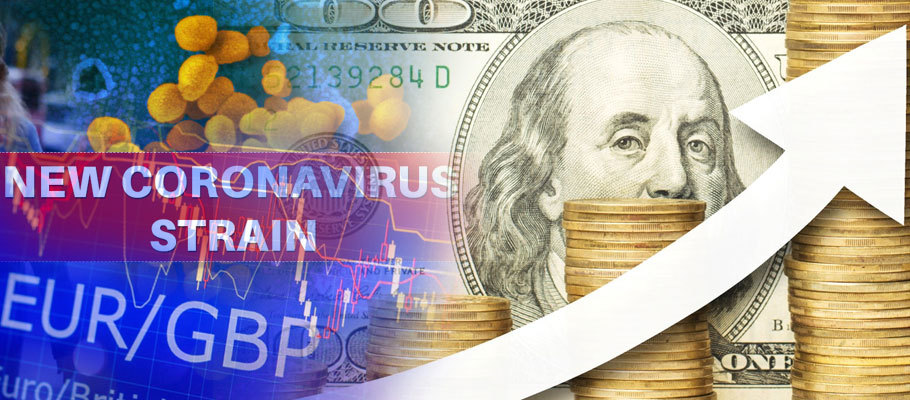
Published: December 25th, 2020
USD jumped out of a two-year trough at the start of the week as a reported new strain of COVID-19 sent a shockwave through year-end markets, where lower trading volumes and reduced liquidity have energised swings in price.
The greenback seemed to reassert its status as the world’s ultimate safe haven, pushing other currencies lower as a mutated, more infectious form of coronavirus drove countries to shut their borders with the United Kingdom and South Africa, where the new strain seems to have taken hold.
The UK found itself set adrift during the start of the traditional Christmas holiday break, with travel restrictions impacting the currency trading in London, virtually the world's forex capital. A falling pound and euro were pulled down by poor liquidity, which also seemed to mark the end of a long period of rising risk tolerance in major currency markets.
Forex analysts at BMO Capital Markets said total open interest in pound-backed futures dropped to 62 per cent of its 3-year average, posting declines in the number of short and long contracts this week. The lack of significant long- or short-term money backing GBP suggests poor liquidity will impact prices considerably during the holiday period up to 1st January.
Greenback rates were universally higher, with the performance pattern in US exchange rates and broader international markets suggesting investors had bigger fish to fry than Britain’s ongoing trade psycho-drama with the EU. The Pound nose-dived against the dollar but was higher against commodity currencies like the Norwegian Krone, and the New Zealand and Australian Dollars.
FX strategists at Rabobank told Bloomberg that vaccine news and belief that the US Federal Reserve will lean on the yield curve if needed has strengthened risk appetite up to this week. Still, now the signs of fraying confidence were becoming apparent. Risk appetite will likely be held in check, they said, by the dawning realisation that economic indicators will be darker in the near term.
Holiday weeks always thin out liquidity, but the unravelling seen in equity markets and risk currencies results from uncertainty. Investors want to see if the new strain of COVID-19 will complicate the efficacy of the vaccines investors have staked hopes on for a strong economic recovery next year.
Market analysts at ING said that closed borders, the more easily transmissible strain of coronavirus, and the return of lockdown measures had all dented confidence in European economies' ability to bounce back in 2021.
‘If the vaccine efficacy rates published to date aren’t swept aside by complications arising from the new strain, we believe the planned additional stimulus coming from the US Congress will reduce the downside risk for activity currencies and limit upside for the Greenback.’
The US government is expected to sign off on a new USD 900bn stimulus package this week.
Britain faces potentially months of economic closures that were not anticipated by the markets. This after health secretary Matt Hancock suggested that a new state of 'lockdown' might need to remain in force until vaccines are available nationwide.
At BMO, analysts said they doubt the Bank of England would intervene to support the pound, however, they will be watching the liquidity situation closely over the coming weeks.
This week, many European counties cancelled flights and cut off transport with Britain, creating chaos for companies and investors just days before Britain is scheduled to depart the European Union.
Adding to the ongoing COVID-19 crisis are fears the UK will crash out of the EU without a trade deal, reverting all trade to higher WTO tariffs.
The UK negotiating team insisted on Sunday that the EU side will change position to pave the way for a post-Brexit trade deal, but so far there signs of a softening by either side on any issues are rare.
Meanwhile, the dollar retreated slightly at mid-week as France announced it would re-open its UK border for freight transport. Medical experts believe the new coronavirus strain is likely already in continental Europe and the US. If that turns out to be the case, then the pound shouldn’t be affected disproportionately, despite being the first country to identify the new strain.
Despite the questions it raises about the prospect of longer and even more stringent lockdowns, analysts believe the new COVID variant is likely to be dollar supportive, and stress riskier currencies more heavily.
An upbeat market mood at the prospects for passage of a new US stimulus bill was soured on Wednesday when President Donald Trump demanded alterations to the bill in a video posted to social media. The video seemed to confuse elements of the relief package with the omnibus spending bill passed the previous week.
The holiday-shortened Christmas week will have an impact on every exchange rate and asset class, with profit-taking and moves exaggerated by the reduction in trading volumes. That could mean more dollar gains, though perhaps less than those seen in March when USD posted massive gains over every competing currency.
The greenback’s slightly subdued response is arguably proof of how effective action by the Fed earlier this year has been. The Fed’s actions seem to have been finely calibrated to stop further destabilising spikes in the dollar. It’s also, however, an unintended consequence of the Fed's actions. Greenback declines in 2020 have been so sharp that the stage may have been set for a reserve currency war that leaves no forex market un-touched.